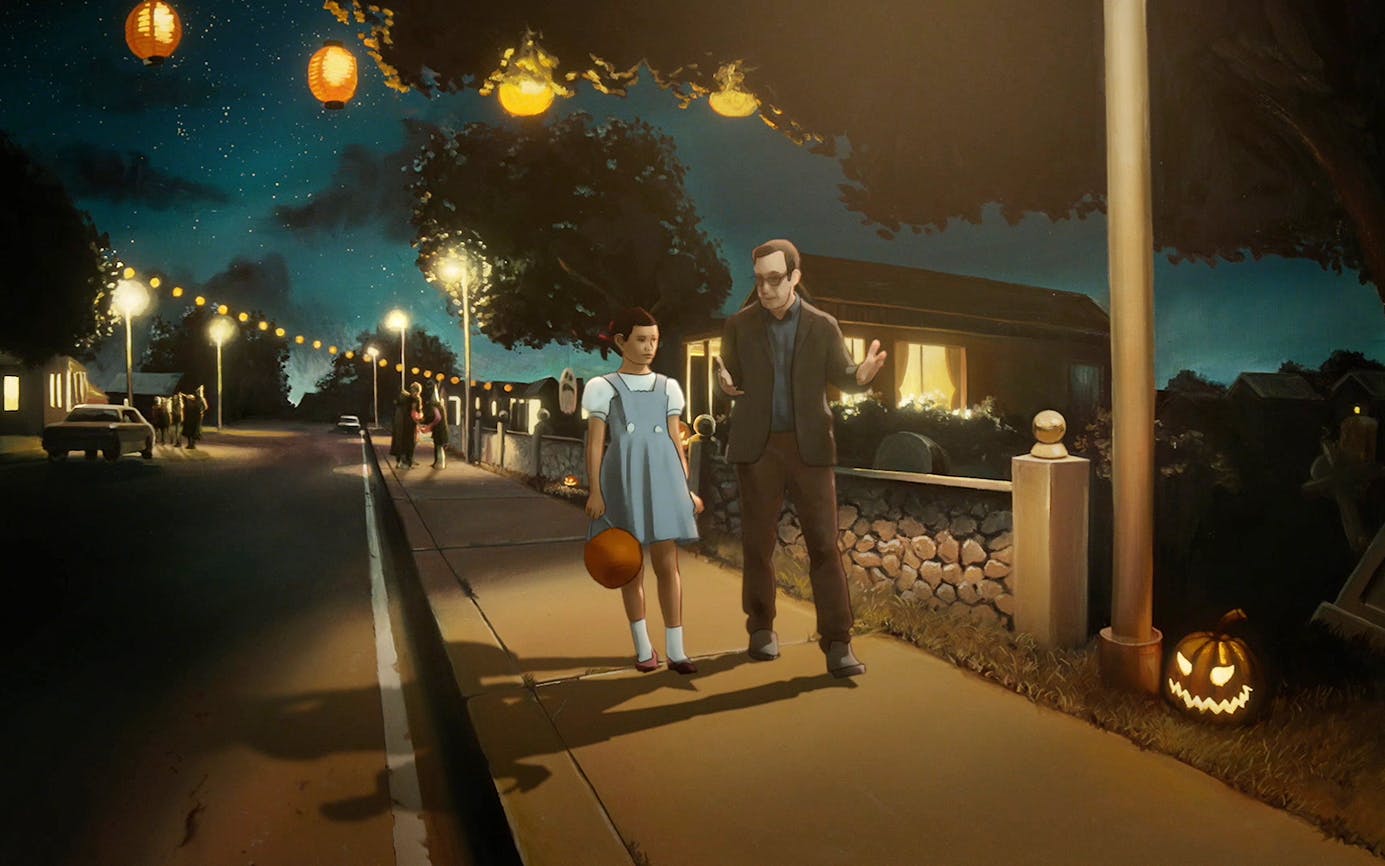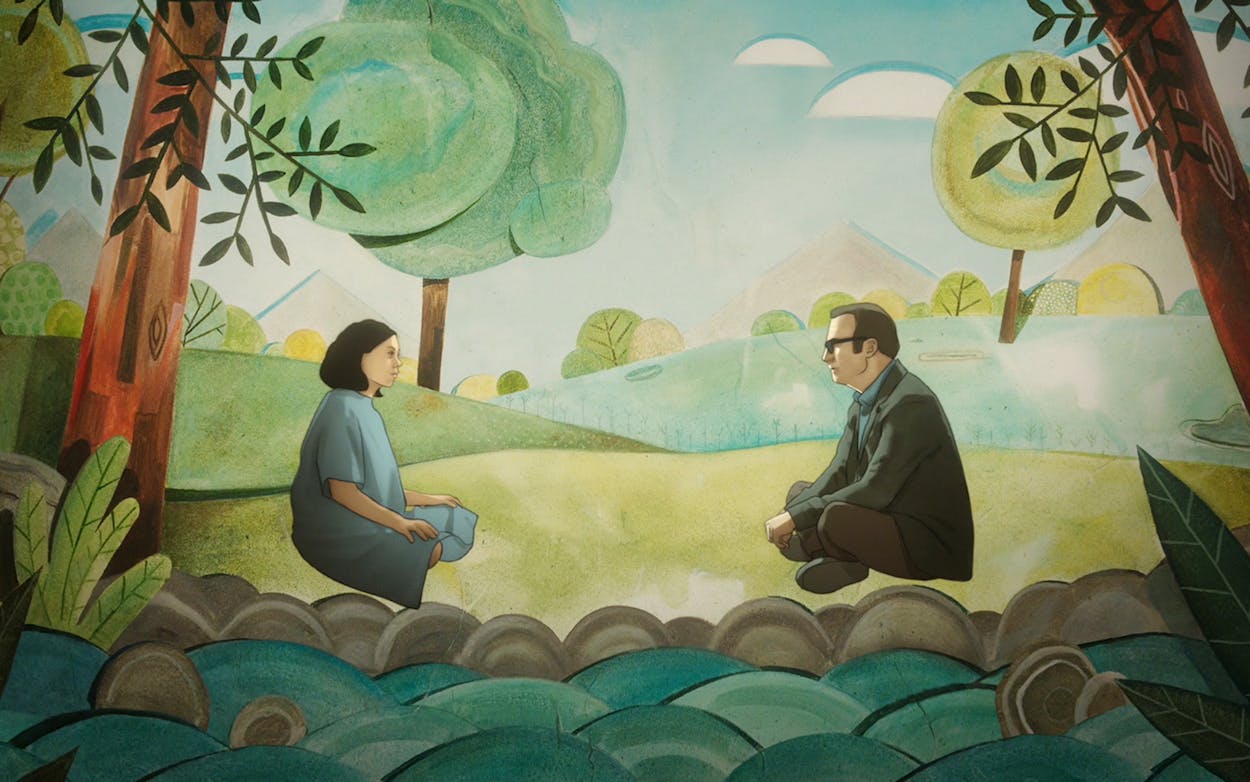Amazon’s Undone is unlike anything else on television. The eight episodes of the show’s first season (which premiered last month) employ digital rotoscoping, a computer-assisted animation technique first developed by Austin animator and software developer Bob Sabiston. Animations are drawn over film footage, which creates images capable of seeming both realistic and fancifully dreamlike at once. Director Richard Linklater was the first to make feature films using Sabiston’s technique, 2001’s Waking Life and 2006’s A Scanner Darkly. A decade later, another Austin filmmaker, Keith Maitland, tapped animation studio Minnow Mountain—which also worked on Undone—to digitally rotoscope the 2016 documentary Tower, about the 1966 University of Texas mass shooting.
But rotoscoping has never been used to produce an entire television series before. Undone tells the kind of story that networks in the pre-streaming age would have likely shied away from. The series focuses on a woman (Alita: Battle Angel’s Rosa Salazar) who, after a car accident, finds herself disconnecting from time and space in ways that may or may not be real, as she seeks to unravel the mystery surrounding the death of her father (Better Call Saul’s Bob Odenkirk) years earlier.
Because of its lineage, digital rotoscoping has told a disproportionate number of stories set in Texas, and Undone numbers among them. The series is set in co-creator Kate Purdy’s hometown of San Antonio. As the series garners rave reviews—it currently enjoys a 100% “fresh” rating on Rotten Tomatoes—we caught up with Purdy to talk Texas, animation, and what it’s like to step outside of reality.
Texas Monthly: Digital rotoscoping is an animation technique that’s almost exclusively been used to depict Texas onscreen. How did you decide on using it for Undone?
Kate Purdy: We’d written the first two episodes—[co-creator] Raphael [Bob-Waksberg] and I written them together—and we actually didn’t know what the style of the show would be. Raphael’s done BoJack [Horseman], so we thought maybe animation, but with animation, the trouble is that you don’t really get the nuance of all the emotion of the characters and their faces. So we thought we could do live-action, but if you go live-action, when the world starts to tear at the seams, it’s going to really feel different. You’re going to see and feel the CGI of it all, and you’re gonna say, “This was reality, now this is not reality.” But the point of the show isn’t to say, “This is true, that is not true.” In fact, the point of the show is to say, “It’s all very fluid, and we all have our own perceptions and no one really knows. In fact, maybe reality is the interaction of all of our perceptions of reality, and not any one single perspective.” So we were back at animation.
We found this artist, Hisko Hulsings, our lead artist and director, and his style is very realistic and very grounded. I thought, “Well, this style is kind of perfect because it feels very real. It feels very painterly.” It invites you to imagine, but it’s also incredibly representative of reality—without saying this is actually reality. So we talked to Hisko, and he was the one who recommended rotoscoping, because he had the same concerns. He said that the projects he found most successful in capturing emotion were the ones he did with rotoscoping, and he had done a project with Tommy Pallotta, one of our executive producers, and Tommy worked with Richard Linklater on Waking Life and A Scanner Darkly, and also helps oversee [animation studio] Minnow Mountain, which is in Austin and did Tower, which is brilliant. So Tommy helped build the pipeline. So we have Minnow Mountain in Austin, and then we have Submarine (the studio in Amsterdam) where Hisko oversees the painters who do all the background paintings, and also the 3D animation artists, the 2D animation artists, and the compositors who composite the entire world, and add the lighting and atmosphere. So that’s how we came to the idea of doing rotoscoping—it was the challenge of the material, and the solution from Hisko, and his background of working with Tommy—who is a Texas native, he grew up around Houston, near NASA.
TM: San Antonio isn’t a city that gets a whole lot of love onscreen. How did you approach bringing San Antonio to life?
KP: I was raised in San Antonio. My mom and her family are all from San Antonio, four or five generations back now. So it’s been a huge character in my life. I was born in Austin, and we lived in Guadalajara for a couple years, but other than that, I’ve been raised my entire life in San Antonio. And I also agree with you. This place isn’t highlighted or showcased enough. It’s such an interesting cultural environment. It’s so beautiful. It has such a rich history. And so we decided to set the show there, just to be able to explore it as an interesting place and location. It’s also three hours from the border, and we’re talking a lot about borders in this—not only in identity, but in reality, so it’s a place that’s between spaces, in a sense. It’s been Mexico, it’s been Texas, it’s been the United States, it’s been native lands and territories through time. I did take a trip down there with my partner, Alex Maloutas, and we took video footage. Tommy was there with us, and he helped us too, and we took photos and stills, and recorded sounds that are layered into the show—the birds of Texas and San Antonio are so vivid and beautiful. So we did our best to capture it, and then share those materials for inspiration and influence for the paintings and the sound design.
TM: The show looks so seamlessly set in San Antonio that it’s hard to believe that you didn’t actually shoot any of the footage in Texas. What was the actual process like?
KP: A lot of people assume that we were actually filming in San Antonio—which is cool, because it’s a trick of the mind. You are in different places. You’re actually all over the world. So we would film here in Los Angeles, in a studio in Hollywood with our actors. They were on an open soundstage with basic props. It was like black box theater. You’d have just two stools, or a high top table that’s your bar, a very limited set. They would perform their scenes, and we would capture them on video. That video then goes to Austin, Texas, and then they hand line-draw the actual actors’ performances. So it looks like a coloring book. It’s a white page with a black line-art drawing of Alma, or Jacob, or Camila, and that’s put into footage—I think they do every other frame—and then you have your episode as a coloring book that’s been line drawn. And then that goes to Amsterdam, and then they paint in the characters, and then they composite them against these painted oil painting backgrounds, and that’s how the show is made. It’s made across the world, at different times, with artists who are really making it by hand.

TM: Based on the things you explore with the show, it seems like having the ability to tap these talents around the world might be really thrilling. Is that a happy coincidence, or something you were interested in actively as you were conceiving things?
KP: Well, the talent pool of rotoscopers happens to be in Austin, Texas. I think probably because of Linklater’s early work, and you have to go where the talent pool is. So Austin was gonna be our home base for their rotoscoping. And then Hisko wanted to stay in Amsterdam, so we figured out this international pipeline with Skype calls, email, our phones. It’s a complicated system.
TM: Do you think that there’s something about the surreality of Texas that makes it uniquely suited to being captured via rotoscoping?
KP: I never thought of that before. I like that question. I want to say yes. I think there is a dreaminess there. I don’t know if it’s brought on by the heat or the humidity, but there’s also kind of a feeling that I get in Texas. It feels so strong in its identity, yet underneath that, there are all these groups and interactions and specific communities that aren’t that definition that I feel like Texas holds up of itself. Which almost makes Texas often feel like all these different outsiders, but we’re all outsiders within this dominant system. It almost feels surreal, like I’m being told what reality is in such a concrete way, yet what I’m experiencing feels so different than that. And I love that about Texas, because it’s so many different things. It’s so natural, and it’s so wild, and it’s so tough but yet so welcoming at the same time. It seems to be a place of contradictions even in its concrete statement of who it is.
I don’t know if this is true, but my experience being from Texas and going other places is that, when you tell people where you’re from it’s like, “Whoa, oh, interesting.” They have such a strong impression of what it is. And it is that, but it’s not just that—it’s also all these other magnificent, wonderful, beautiful, creative, incredible things you have to get under the surface of. It’s a thick blanket to get under, but once you’re there, it’s really incredible.
TM: Undone, A Scanner Darkly and Waking Life, and Tower are all set here, and they all use the same animation style, but they use it to really different effect and to say different things. Do you think there’s a unifying theme in how rotoscoping is utilized?
KP: People often say, “If you’ve seen A Scanner Darkly, it’s like that.” And it is like those things, but it’s also its own thing, too. It has its own style, and it feels different than that. So it’s nice to sort of have something as a frame of reference, but at the same time, it’s its own thing. It’s saying this is reality, but this isn’t exactly reality. And you can use that for different effects for different reasons in your storytelling. We’re reaching reality, we’re touching it, but we’re also not pretending to be it.
This post has been modified since publication.
- More About:
- Film & TV
- Richard Linklater
- San Antonio








